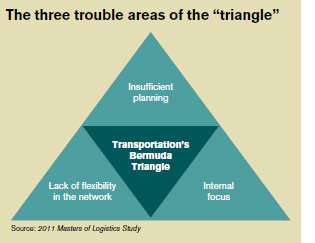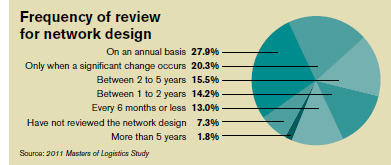20th Annual Study of Logistics and Transportation Trends
/Extracted 07SEP2011 from http://www.logisticsmgmt.com/article/navigating_transportations_bermuda_trian...
The Bermuda Triangle facing logistics and supply chain managers consists of:
(1) a lack of planning for the impact of rising fuel prices;
(2) a rigid network that is incapable of flexing when uncertainty occurs, and;
(3) a myopic internal focus that limits the enterprises’ ability to achieve the desired performance results.
Data show that 27.9 percent of the study participants review their network design on an annual basis. However, it’s imperative that the results of these reviews be translated into tactics and then operational actions. The data Frequency of review also suggest that these links are currently not for network design as strong as needed. Furthermore, 20.3 percent of the study respondents reported that they only review their network design when there’s a significant change, such as a merger, acquisition, or divestiture.
The data show that many of the actions that have the capability to improve supply chain flexibility are in the planning stage. They include reducing supply and order-fulfillment lead time; improving integration of information systems with external customers and suppliers; and increasing collaboration with key suppliers.
The study results indicate that there remains a meaningful planning gap between the firm and its key customers and suppliers... Engaging suppliers and customers in supply chain initiatives, especially at the planning stage, has the potential of improving everyone’s efficiency and effectiveness. The bright spot on the horizon is that many study participants reported that they are currently implementing increased collaboration with key customers and suppliers.
One hurdle of using manual methods, spreadsheets, and software developed in house is that they make it very difficult to achieve the level of visibility that’s needed for a seamless flow of data and information in a supply chain. Highly visible data and information increases the likelihood for more optimal decision making.


